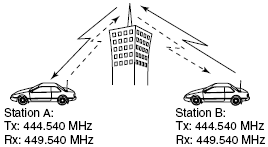

v Repeaters vs. Simplex
A repeater will extend the distance you can talk with the same amount of power. A repeater can do this because it usually has a higher antenna and more RF power output. Simplex is simply from your radio/antenna to another radio/antenna directly. When talking on a repeater you can check the input frequency for the repeater to hear (if you can) the station you are talking with on the repeater. You may not be able to hear the other station if he is too distant, and/or running low power, and/or has a low antenna. More on the input frequency in the next section. It is a good idea as you operate on a repeater to learn where you start to have a hard time being heard by others. Sometimes this may be called “reaching the end of your string” or other lingo.

PROVIDE IMAGE OF REPEATER vs. SIMPLEX range
v Repeater shifts
The repeater shift on 2M is 600 kHz. The repeater shift on 440 MHz (70 CM) is 5 MHz. On 2M, depending where you are in the 2M sub-bands for repeaters (there are 3 repeater sub-bands), the offset will be 600 kHz lower or higher that the repeater output frequency. PROVIDE DRAWING OF REPEATER SUB-BANDS. That means that if you hear a repeater on for example 147.200, the input frequency (or offset, or repeater shift frequency) will be on 147.800. (In this particular example, the repeater shift is a positive offset.) Your radio should be set up in this case for a positive offset being that your transmit is higher than the repeater frequency. In this example, your radio transmits on 147.800 to the repeater (as does everyone else with their radios), which is listening on this frequency, it simultaneously retransmits your signal out on 147.200 to someone who is listening there. (If you get down to the nitty-gritty technical side, there is a small latency of time for the signal to pass thru the various stages of the electronics. If you were to quickly check a station on the input and output of the repeater, or simultaneously, you could notice a small delay.) They would do the same as your radio to reply to you...that is, they would transmit on 147.800 to the repeater. If the 2M frequency for the repeater is between 145.200 MHz and 145.500 MHz, or ###.### and ###.### MHz, you would use a negative offset. If the 2M frequency for the repeater is between 146.610 and 147.395, you would use a positive offset. (Some hams may ask you to check their signal on the "reverse", this is the same as the input frequency.) If you are able to hear a station on the input, you are within simplex range, and do not need a repeater.
Many current 2M radios have a menu option that will automatically determine the appropriate offset when you program a repeater frequency into a memory channel.
Depending on various other factors, these being: possible expected usage of the repeater by mobiles during commute time, a scheduled net time approaching, or that particular repeater's etiquette, amongst other reasons, you might want to think about moving your conversation to another simplex frequency so as not to monopolize the repeater. This might be the case if you are talking from your home to another ham in his home. It's not always wrong, or by any means illegal, it might be thoughtful. There may be times that you feel contrary to this if you wish to speak with anyone else, including a mobile station who might need the repeater to communicate with you if he is outside of repeater range. Just keep it in the back of your head.
Many current production V/UHF radios have a function that will allow you to scan for PL tones. If you were in an area that you did not know the PL tone to access a repeater, you might possibly be able to find the proper tone. You would do this by scanning for a tone IF you were able to hear a station on the INPUT frequency of the repeater. If you were to scan and find a tone on the output of the repeater it may be different than the tone of the input to allow you access to the repeater. Remember some repeaters output a tone to help users with other functions such as cross-banding. So, if you wish to find the PL tone to enable you access to the repeater, and it is being used, check the input to see if you can hear one or more stations. (You may not be able to hear any of the stations on the input.) Then once you can hear a station on the input, start your tone scan. The way many of my Icom radios do this, is to press [FUNC], then [T-SCAN] on the microphone control. There will be a signal showing on the S-meter, but no audio, until it finds the proper tone. The PL tones will scan (somewhat slowly) while there is a signal present, then stop once it finds the tone, and at that time you will hear audio. You now know what PL tone to use for accessing the repeater. There are other ways to determine the PL tones for repeaters. One common way is to purchase the Repeater Directory from ARRL. The ARRL also has software that you can map a route and it will tell you in order of your trip which repeaters, and all the necessary info, that you might be able to access along the way. There are also online sources such as the website: http://www.artscipub.com There are also individual states' repeater coordination councils that may also provide listings of coordinated repeaters. Here in Michigan we have the Michigan Area Repeater Coordination Council, their website can be found @: http://www.miarc.com.